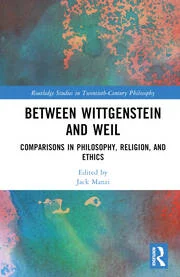“Between Wittgenstein and Weil: Comparisons in Philosophy, Religion, and Ethics” (excerpt)
The following excerpt is from the introduction to Between Wittgenstein and Weil: Comparisons in Philosophy, Religion, and EthicsRoutledge (London: 2023, Taylor & Francis Group), which is edited by Jack Manzi.

This book compares the philosophical, religious, and ethical thought of the French philosopher Simone Weil (3 February 1909-24 August 1943) with that of the Austrian philosopher Ludwig Wittgenstein (26 April 1889-29 April 1951). Motivating this comparison is the surprising number of parallels that exist between them. Both lived and worked during the early twentieth century, against the backdrop of war. Both lived in a tense relationship with religion. Both were, at times, tempted by the teachings of Catholicism. Both underwent a profound and transformative mystical turn early into their careers. Both operated against the backdrop of escalating global conflict in the early twentieth century. Both were concerned, amongst other things, with questions of culture, ethics, aesthetics, epistemology, science, and necessity. And, perhaps most notably, they both sought to radically embody their ideas and physically ‘live’ their philosophies.
Interestingly, despite at times being concerned with similar issues and exploring similar themes, and despite even living in the same city, at the same time, and being involved in similar work (London, 1943), both seemed to be completely unaware of the other. One can only speculate as to what Weil might have made of Wittgenstein and vice versa, or whether the pair of them would have found any common ground. It is not the purpose of this book to try and speculate that. Rather, it is to see whether students of Weil and Wittgenstein, generations later, can find some fruitful common ground in comparing their philosophical thought, given the many similarities that they (at the very least, superficially) seem to share.

Despite these similarities, there has been very little work in bringing these two philosophers together, outside of some notable exceptions. Wittgenstein’s student, Rush Rhees, found himself drawn to Weil’s work, finding many similarities between the two. Rhees’ Discussions of Simone Weil approaches some of the major themes of Weil’s work through a Wittgensteinian lens and, in particular, explores compatibilities in both thinkers’ thoughts on religion. Similarly, Peter Winch brings Weil and Wittgenstein Weil’s thoughts on religion and philosophy by exploring rich and fruitful parallels with Wittgenstein.’ But outside of Winch’s and Rhees’ respective treatments, there exists no exhaustive attempt to flesh out the similarities between these two philosophers.
This book seeks to address this, by collating nine new essays on the similarities (and dissimilarities) between the philosophical, religious, and ethical thought of Simone Weil and Ludwig Wittgenstein. For those readers that are coming from Weil to Wittgenstein, or from Wittgenstein to Weil, it might be useful to first survey the intellectual lives of these two thinkers.
Table of Contents
List of abbreviations xi
Introduction 1
JACK MANZI
1 Ludwig Wittgenstein, Simone Weil, and Religious Belief by MARIO VON DER RUHR // 14
2 To Speak of the Divine: Weil and Wittgenstein on Religious Grammar by JACOB QUICK // 30
3 Learning to Look: On Mysticism and Mysticisms by PHILIP WILSON // 56
4 Will the Void: Wittgenstein and Weil on the Ethics of Attention by HANNAH WINTHER // 83
5 Struggling with the Supernatural by HUGO STRANDBERG // 106
6 Weil Meets Wittgenstein by PALLE YOURGRAU // 125
7 Writing (Out) the Self: Wittgenstein and Weil on Diaristic Writing by JACK MANZI // 151
8 Affliction: Pain and the Problems of Modernity by C. M. DJORDJEVIC // 176
9 Wittgenstein and Weil on Manufacturing Good by DAVID LEVY // 212
Index 233
Contributors
- C. M. Djordjevic, Lorraine County Community College, Elyria, United States of America
- David Levy, University of Edinburgh, Edinburgh, U.K.
- Jack Manzi, University of East Anglia, Norwich, U.K.
- Jacob Quick, KU Leuven, Brussels, Belgium
- Mario von der Ruhr, Swansea University, U.K.
- Hugo Strandberg, Äbo Akademi University, Finland
- Philip Wilson, University of East Anglia, Norwich, U.K.
- Hannah Winther, Norwegian University of Science and Technology, Norway
- Palle Yourgrau, Brandeis University, Massachusetts, United States of America


